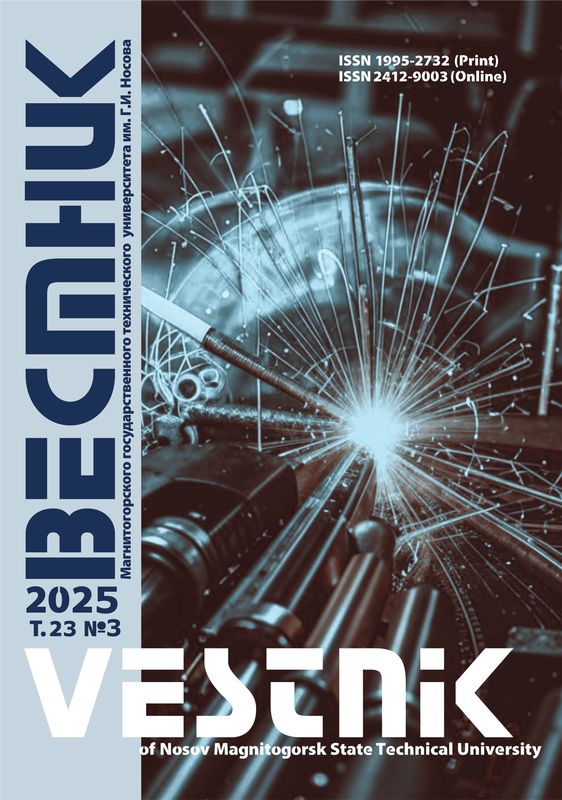DOI: 10.18503/1995-2732-2023-21-1-100-108
Abstract
The Chelyabinsk Region is home to many industrial companies, applying various heat and mass transfer facilities, namely reactors of fuming furnaces, basic oxygen furnaces, bubble columns, heterogeneous catalysis and chemical synthesis facilities, etc. The said facilities operate with chemical reactions at pressure and high temperatures accompanied by phase transitions. The products of these reactions make up a significant share of hazardous environmental emissions during the charging of bulk material into the internal chamber of the reactor. A mechanical shut-off device is open when charging. The chemical reactions take place at excessive pressure, which leads to the exhaust of hazardous gases through the charging opening. At the same time, the operation of mechanical shut-off devices is associated with relatively frequent failures. The paper presents a pneumatic ejection-type shut-off device that does not contain moving mechanical parts as an alternative to a mechanical shut-off device. Hazardous emissions are prevented by a countercurrent high-speed air jet from the nozzle of the shut-off device into the charging tube, which is also a mixing chamber of the ejector. This significantly reduces environmental pollution. Moreover, injection of additional air into the reactor through the ejector device intensifies the chemical processes in the reactor. A complex gasdynamic process of mixing active and passive gas or mixture flows takes place in such pneumatic shut-off device. There is no available theory for calculating ejection-type pneumatic shut-off devices. This paper presents a mathematical model of the operating process and a calculation method for designing an ejection-type pneumatic shut-off device, which allows developing pneumatic gates with minimum required air consumption.
Keywords
exhaust, hazardous gases, shut-off device, ejector, pneumatic gates, mathematical model, characteristics, calculation method
For citation
Spiridonov E.K., Ismagilov A.R., Khabarova D.F. Research and Development of a Pneumatic Shut-Off Device of an Ejection Type to Prevent the Exhaustof Hazardous Gases. Vestnik Magnitogorskogo Gosudarstvennogo Tekhnicheskogo Universiteta im. G.I. Nosova [Vestnik of Nosov Magnitogorsk State Technical University]. 2023, vol. 21, no. 1, pp. 100-108. https://doi.org/10.18503/1995-2732-2023-21-1-100-108
1. Bigeev V.A., Vdovin K.N., Kolokoltsev V.M. Osnovy metallurgicheskogo proizvodstva [Fundamentals of metallurgical production]. Saint Petersburg: Lan; 2017. 615 p. (In Russ.)
2. Alexandrov V.Yu., Klimovsky K.K. Optimalnye ezhektory (teoriya i raschet) [Optimal ejectors (theory and calculation)]. Moscow: Mashinostroenie; 2012. 136 p. (In Russ.)
3. Zucker R.D., Biblarz O. Fundamentals of gas dynamics. 3rd Edition. Wiley; 2019. 560 p.
4. Arkadov Yu.K., Zernov V.R., Shmukler B.Yu. Ejector gas filling systems for emergency rafts and evacuation slides of civil aircraft. Uchenye zapiski TsAGI [TsAGI (Central Aerohydrodynamic Institute) Science Journal]. 1992;23(3):54-59. (In Russ.)
5. Guerrero A.P., Paredes G.E. Linear and non-linear stability analysis in boiling water reactors. The Design of Real-Time Stability Monitors. Woodhead Publishing Series in Energy; 2019. 465 p.
6. Zhang H., Zou D., Yang X., Mou J., Zhou Q., Xu M. Liquidgas jet pump: A review. Energies. 2022;15(19):6978.
7. Haidl J., Mařík K., Moucha T., Rejl F.J., Valenz L., Zednikova M. Hydraulic characteristics of liquidgas ejector pump with a coherent liquid jet. Chemical Engineering Research and Design. 2021;168:435-442.
8. Bhatkar V.W., Sur A. An experimental analysis of liquid air jet pump. Frontiers in Heat and Mass Transfer. 2021;17:12.
9. Zhao J., Wei X., Zou J., Zhang Y., Sun J., Liu Z. Research on performance optimization of gasliquid ejector in multiphase mixed transportation device. Journal of Mechanics. 2022;38:22-31.
10. Sokolov E.Ya., Zinger N.M. Struinye apparaty [Jet devices]. Moscow: Energoatomizdat; 1989. 352 p. (In Russ.)
11. Bachurin A.B., Rusak A.M., Tselishchev V.A. Experimental and theoretical studies of flow features in adjustable nozzles with a central body. Vestnik Ufimskogo gosudarstvennogo aviatsionnogo tekhnicheskogo universiteta [Bulletin of Ufa State Aviation Technical University]. 2010;14(5(40)):52-61. (In Russ.)












